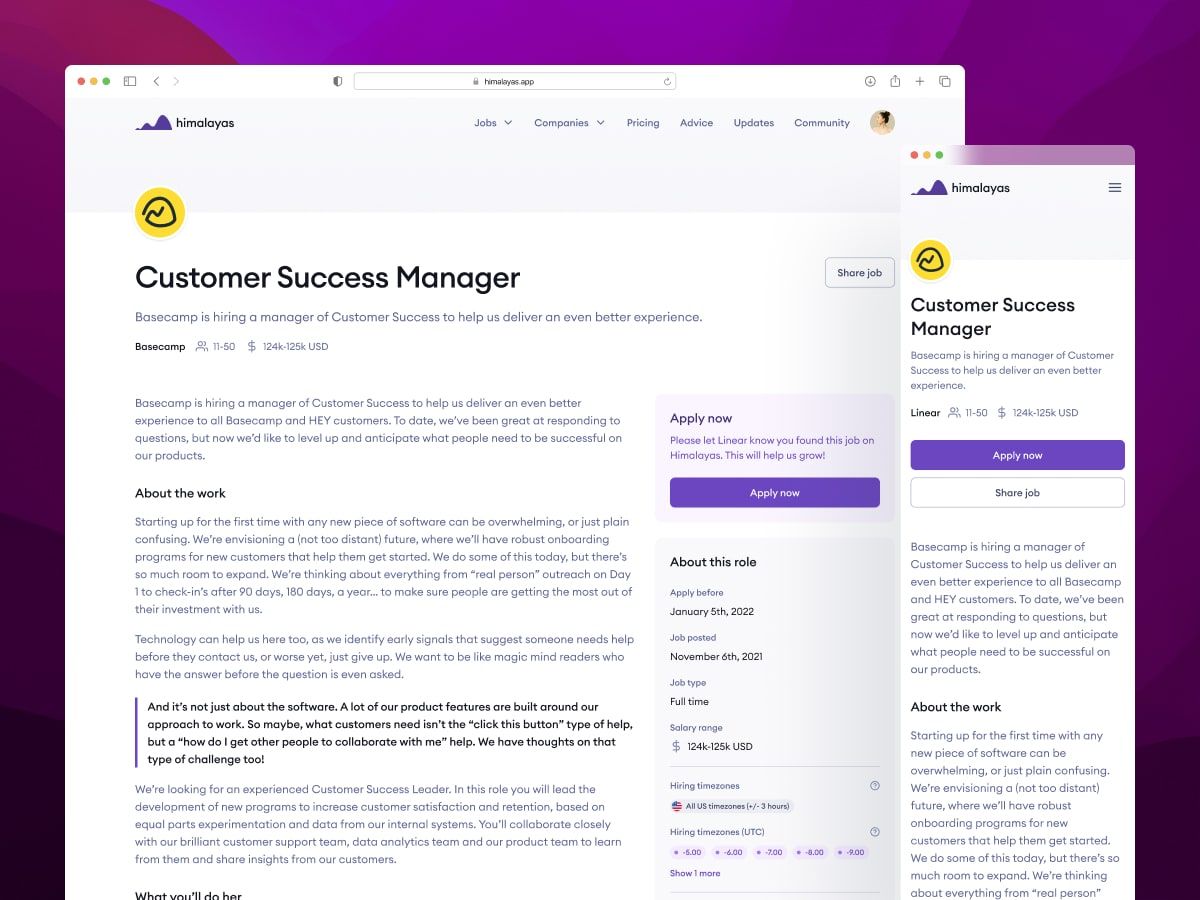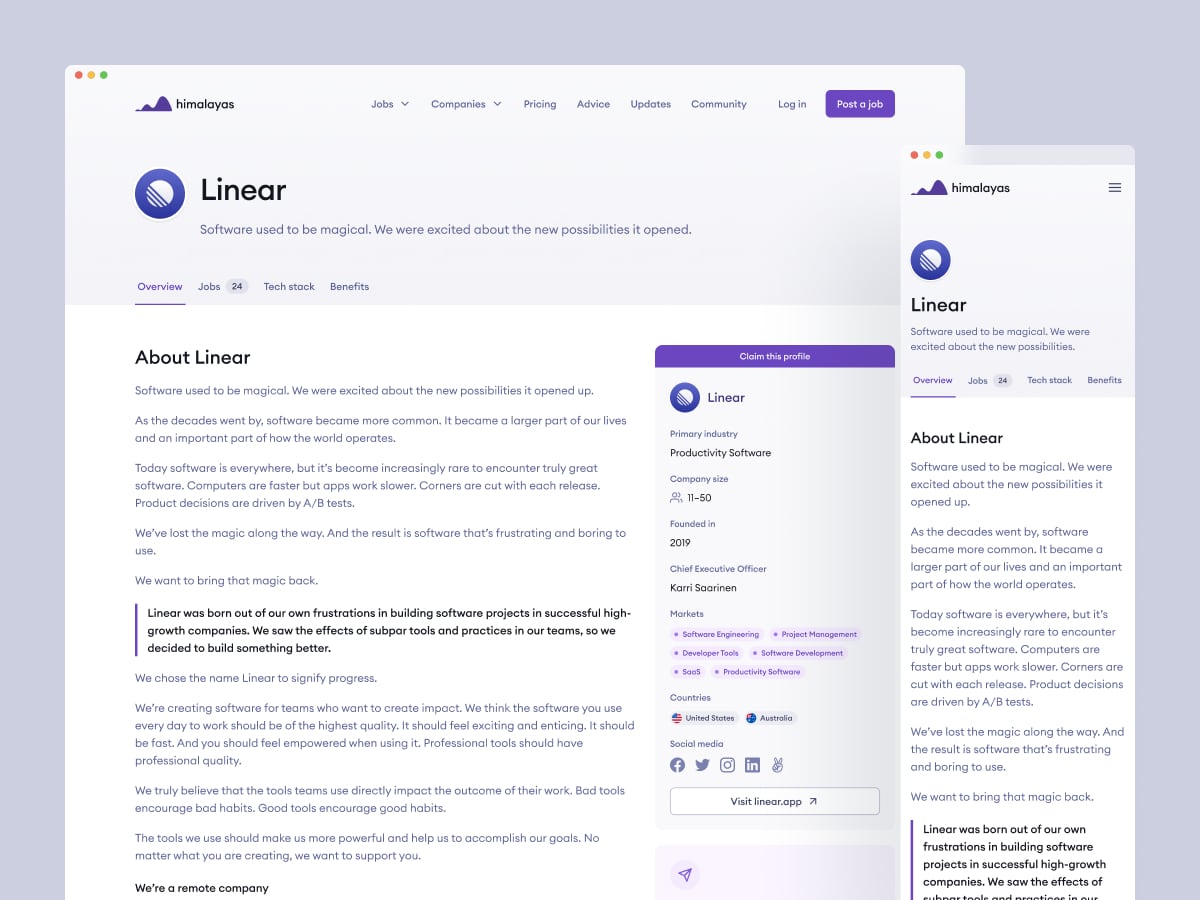The COVID-19 pandemic has forced many organizations to transition to a remote workforce. As many companies make the shift to remote work permanent, they're hiring leaders to facilitate the shift, commonly known as Heads of Remote.
The Head of Remote position was first suggested by Andreas Klinger, CTO at On Deck, and pioneered by GitLab co-founder and CEO Sid Sijbrandij and Darren Murph. Heads of Remote are dedicated leads tasked with improving a company's remote fluency.
In this article, we'll outline what a Head of Remote is, what they do, why it's important, and how to get a job as one. We'll also outline how to hire one, provide job description templates, and more.

What is a Head of Remote?
A Head of Remote is the person on an organization's leadership team who is responsible for remote company culture and employee experience. Depending on the organization, this could include managing remote operations, partnering with IT to develop cybersecurity measures for remote employees, facilitating strong interpersonal relationships between team members, or teaching staff how to move toward a remote-first culture based on asynchronous communication.
Types of Head of Remote roles
Not all Head of Remote roles are structured the same, but there are two primary types of roles with key differences based on the organization's objective for the position:
- Internal advocates: Primarily responsible for ensuring an equal employee experience across the organization regardless of where employees live. This type of role is typically aligned with business operations or human resources.
- External advocates: Primarily responsible for telling the story of remote work at the organization to the world. This position primarily relates to marketing and public relations, helping attract top talent, and supporting the company's position as remote-first or remote-friendly.
That's not to say all Head of Remote roles fall neatly into these categories. Many Heads of Remote will spend time in both worlds, improving the internal experience while advocating for remote-first beyond the organization.

What does a Head of Remote do?
The Head of Remote role is intrinsically cross-functional, working at the intersection of culture, operations, people, talent branding, marketing, and communication.
That translates to a lot of responsibility in a fully remote company, and even more in a hybrid company. Some common projects, initiatives, and tasks Heads of Remote manage include:

1. Creating and implementing a remote employee handbook
Remote companies need a single source of truth to operate effectively. This is why the best remote teams are handbook-first. An employee handbook (or company handbook) is a written document outlining a company's mission, culture, core values, policies, procedures, teams, best practices, and any other information remote workers need to do their work.
While it can seem inefficient–even a waste of time–to document everything, the benefits of intentionally documenting your company's mission, processes, culture, and best practices are enormous.
Heads of Remote are often responsible for setting up the initial structure of a remote employee handbook and then teaching remote employees how to contribute.
Not to mention that company handbooks often double as recruiting tools, they're one of the best ways to attract remote job seekers who resonate with your company culture and mission.
Check out our post on the best remote employee handbooks.

2. Creating and implementing the remote strategy
Outside of the employee handbook, a Head of Remote can be responsible for developing, designing, and delivering personalized programs to help every employee work successfully.
This can include researching, testing, and implementing new ways of working or new tools to enable better remote collaboration between employees, crafting a strategy around remote hiring, or developing a training and remote onboarding program to set new hires up for success.

3. Developing onboarding, training, and learning and development programs
Heads of Remote need to set remote teams up for success and that may mean ensuring that remote onboarding, training, and learning and development (L&D) opportunities are available.
Depending on the size of the remote organization, this could be by creating and facilitating the training themself, or working with HR to ensure that the company's training, onboarding, and L&D programs are set up to support a remote employee experience.

4. Contributing to employee experience and company culture
Two of the most common challenges for remote workers are overworking and loneliness. One of the most important jobs for a Head of Remote is to create a positive and consistent remote experience while ensuring the company culture is maintained and improved.
This can include things like ensuring every employee has a comfortable remote workstation, planning remote team-building activities, and educating new remote hires about the company's mission, values, and work style.
If it's a hybrid organization (meaning some employees work remotely while others work from a shared location), a Head of Remote will need to normalize the idea of being remote-first. This can include things like always dialing into meetings (even if you're in the same location), being time zone conscious, and focusing on asynchronous over synchronous communication. Other examples include not defaulting to meetings, being documentation first, and working transparently.
Remote work is a massive shift and hybrid is even more complicated, things will take time but a Head of Remote is foundational to creating a successful and lasting remote future.
In short, a Head of Remote needs to ensure that employees can succeed regardless of whether they're working remotely or in an office, and that remote is a core part of the company's culture.

5. Partnering with other departments to ensure remote success
Heads of Remote tend to lead remote strategy and operations. But they need to work with leaders throughout the company to ensure that new initiatives are implemented, managed, and most importantly, successful.
How this happens will depend on the organization, but some examples include:
- Working with finance to develop budgets for remote employee perks such as home office stipends, co-working stipends, or even money to spend on remote collaboration tools, project management software, or better Internet.
- Collaborating with HR to develop and implement programs to onboard and engage remote employees
- Working with recruiters to develop ways to attract and hire remote job seekers
- Partnering with IT to develop a robust remote cybersecurity program

6. Measuring and improving the organization's remote operations
In order to succeed with remote work over the long term, Heads of Remote need to continually monitor and measure the success of their remote strategy and programs – then adjust accordingly.
This can be achieved by asking for employee feedback on new tools, policies, or procedures, measuring employee engagement and productivity, and introducing remote work best practices. A good start is implementing a remote employee handbook, encouraging employees to contribute, and then tracking the percentage of employees who contribute over a given month or quarter.

The importance of a Head of Remote role
Remote work isn't a new concept. But the COVID-19 pandemic forced many companies to send their employees home and make the shift to 100% remote operations. And while many of the myths of remote work were busted (for example, challenges with productivity, company culture, and employee engagement), remote work isn't without its challenges.
The success of your remote teams is too important to leave to chance, like any important function, you need to have a directly responsible individual.
If you're running a hybrid company–a company with in-office and remote people–the challenges are compounded. You need to manage two opposing cultures and workflow defaults, which only reinforces the need for remote to be someone's full-time job.
In lieu of hiring a full-time remote work leader or as a bridge until you do, consider working with a specialty consulting firm like Distribute Consulting, Global Workplace Analytics, or Remote-how.

How to hire a Head of Remote
The Head of Remote role is new and unique. One option is to hire a former CEO or founder who can play a large role in company culture and leadership.
Darren Murph, Head of Remote at Gitlab, is one such example. Darren took on the role in July 2019, after serving as Founder and CEO of Page 52 Consulting where he served as a senior advisor to startups and multi-national corporations. His expertise is in media relations, content creation, product management, messaging, social influence, and improving efficiency within a business.
Darren also spend his entire career across the spectrum of remote – over 15 years leading remote teams and charting remote transformations in co-located spaces, hybrid-remote companies, and all-remote companies.
Finding a leader with extensive remote experience and a history of successful business and cultural transformation like Darren is difficult. You may want to hire someone to build out your remote employee handbook and establish a documentation strategy then morph them into a more encompassing role over time. Former editors, publishers, and librarians are often suitable.
Regardless of the approach, here are five steps you should follow:

1. Get buy-in and understand the role
If you haven't already, your first step is to ensure senior leadership is bought into the role and that the person who is hired will be able to work with them. The Head of Remote role is cross-functional by design and they need access to the company's key stakeholders to drive change.
Whether you hire an externally- or internally-focused Head of Remote will depend on whether you're constructing or maintaining a remote work program. It's crucial to understand the difference between construction and maintenance. Construction requires extensive experience in remote organizational development, while the latter can be fulfilled by anyone with strong communication skills and a passion for workplace flexibility.
You're likely constructing a remote work program if:
- Leadership hasn't fully bought into remote or you haven't decided on whether you'll be hybrid or fully remote
- Your employee handbook is non-existent or hasn't been updated to include remote work
- Processes and work style is the same as when you were working in the office
Inversely, your company is maintaining a remote work program when:
- Learning and development programs have been updated to improve remote work skills
- Company culture has been converted from located-dependant to location-agnostic
- You are remote-first rather than remote-friendly, relying on async over sycn communication
As a rule of thumb, the more you move toward maintaining remote work, the more likely you'll be looking for an external over an internal advocate. Another way to think about is based on the percentage of your workforce working remotely. If it's between 1-50%, you probably want an internal advocate and if it's 50-100% you'll likely want an external one.
Outside of the internal vs external debate, try to answer these questions ahead of time:
- What department will the Head of Remote report into?
- Who will they report to?
- What is our budget for the position?
- What are our requirements?
- Does it make sense to hire a consultant for the role rather than a full-time resource?
- If we can't find a senior person, would we be open to hiring someone more junior and then supporting them with an outside consultant?

2. Set clear expectations for the Head of Remote role
We recommend getting clear on the expectations of the role before writing the job description for the Head of Remote role.
There are typically three aspects you'll want to think through:
- Responsibilities: These will depend on whether you're hiring an internal or external advocate. Internal advocate responsibilities will typically include monitoring employee performance, planning engagement strategies, and building resources like a remote employee handbook for internal use. External advocates responsibilities include attracting talent, supporting the company's position as a remote-first or remote-friendly company, and thought leadership.
- Skills and experience: You'll want to hire someone with experience in remote collaboration, ideally in cross-functional roles who can play a central role in nurturing company culture and organization-wide transformations. Heads of Remote need to be able to influence and gain consensus from executives, communicate complicated ideas to employees, and work across teams and departments. You'll also want them to be well-versed in important remote work skills.
- Qualifications: While case studies are percolating through the university system, there is still no well-defined career path to becoming a Head of Remote. Look for people with experience in industrial or organizational psychology, organizational design, organizational change, and organizational or workplace communication. People who have completed GitLab's Remote Work Foundations Certification and course on How to Manage a Remote Team are also good to look out for.

3. Create a clear job description for the Head of Remote Work role
Now that you're clear on what you're looking for, invest the time into writing a compelling job description, taking into account how experienced your company is with remote work.
If you're looking for inspiration, GitLab has put together a comprehensive list of Head of Remote (or similarly titled roles) job descriptions.
An informative and compelling Head of Remote job description will contain many of these elements:
- Job title: The name assigned to Head of Remote at your company. The job title is how most job seekers decide whether to read the job description or not. This could be titled Head of Remote Work, Director of Remote Work, VP of Remote Work, Chief Remote Officer, or a variety of other seniority levels. Longer-term, this role may evolve into a Head of Workplace Experience, Head of Culture, or even a Chief People Officer.
- Job level: Typically only applies at larger companies, but job levels or job grades are formal categories of increasing responsibility and authority in the company. The higher the level, the more autonomy, responsibility, and compensation the role has and the greater the skill, accountability, and independence.
- Location: Make it clear in the description whether the role is fully remote or whether there are any time zone or visa requirements (e.g. "Australia only", "time zone agnostic", or "4 hours overlap with UTC+4 required")
- How remote works at your company: Remote work can vary from work from home but located in the same city or time zone to fully distributed and asynchronous like GitLab. No approach is better than another but it's important for candidates to know what they're getting into.
- Company name (including logo and branding): You need to sell your company as much as the role itself. Good design and branding can go a long way.
- Company narrative: This will typically describe your mission, origin story, and company vision. It should also include a brief pitch about what it's like to work at the company, as well as your company values and culture.
- Role narrative: A short story illustrating what it would be like to work as Head of Remote and what the ideal candidate looks like. It could include the outcomes of the role, how it could benefit the candidate's career, why you're hiring for the role, characteristics and skills that will help the candidate succeed, and how Head of Remote fits into the overall company.
- Outcomes expected for the role: What are you expecting the candidate to achieve if they are hired. You don't need to be hyper-specific, you just need to give potential candidates a sense of the tasks that they could be working on and whether they have relevant experience or skills.
- Skills and experience required to meet expected outcomes: You need find a balance between making the skills and experience required too specific (which can cause good candidates to self-select out) and too broad (which makes good candidates with relevant experience less likely to apply). Experience doesn't always translate to seniority or ability and there is research that some candidates, particularly women, will only apply if they meet all the requirements. Only put requirements in here that are truly requirements. If you don't need it, don't include it.
- Traits and values of the ideal candidate: Help people understand the type of person you are looking for while doing your best to be inclusive. Aim for culture-add rather than culture fit.
- Compensation, benefits, and perks: While you don't want to attract people who are solely interested in what you can offer them, fair compensation and good remote employees benefits are a great way to attract candidates. We recommend including a compensation range as you'll filter out applicants who are expecting a higher salary and job posts with transparent salaries drive more applicants.
- How to apply: This may seem obvious but you'd be amazed how many companies forget to add this to their job descriptions.
- What to expect during the hiring process: Again, this may seem obvious but most companies fail to provide applicants with a clear understanding of what to expect during the hiring process. Providing this will help candidates prepare and will help filter out any potential applicants who aren't serious about applying.
- EEO statement: An equal employment opportunity statement (EEO statement, equal opportunity employer statement, or diversity statement) shows that your company is operating in good faith and part of how you can market yourself.
Providing this level of detail will turn some people away. Those people aren't a good fit for a Head of Remote role anyway and the applicants that do apply will be more invested in the process and your company.

4. Post the job on remote job boards
Consider posting on remote job boards like Himalayas. Despite the enormous size of the remote talent tool, don't be surprised if attracting remote candidates is harder than you first anticipate. Particularly if your company isn't known for having a remote work culture.
The Head of Remote role is still new, so there aren't necessarily a lot of people searching for it directly, so be sure to read our guides on how to attract, hire, and onboard remote employees as well.

5. Prepare for and conduct interviews
When preparing for the Head of Remote job interviews, remember that it's a conversation and not an interrogation. The candidate is assessing whether they want to work at your company, as much as you are assessing whether they are a good fit.
Below are questions you could ask:
- How would you train and upskill newly-remote managers, collect feedback on training, coach them on unlearning in-person approaches, and teach them to motivate reports who are physically distant?
- What perks do you think we should offer to remote workers? And how do we ensure that benefits are equivalent between remote and in-person workers?
- How would you ensure that tools that don't support async communication are deprecated or replicated, and that existing tools are used in remote-first ways?
- How will you create, establish, and champion our documentation strategy?
- Which companies have the best remote employee handbooks?
- How will you coach and convince executives on the benefits of being more remote by default?
- How will you ensure that promotions aren't tied to physical proximity?
- How will you be the voice of the distributed worker, ensuring equality and belonging even for those who never step foot in the office?
- How will you ensure that newly-remote workers have a safe and ergonomic workspace at home?
- How will you roll out learning and development programs to address the challenges of remote hiring, interviewing, onboarding, management, promotions, and beyond?
- How can we reduce our reliance on synchronous communication?
- Have you managed an in-person company retreat before?
- Do you think we need to adjust our company values to ensure that remote workers are equally valued?
- How does a remote organization's talent acquisition strategy differ from an in-person company?
- How will you build a talent brand that attracts and retain talented remote employees?
- How can we transform expectations and ways of working and embrace a remote-first culture?
- What would you like to achieve in your first six months if hired as Head of Remote?
- How is a remote organization different from a hybrid organization?

How to become a Head of Remote
If Head of Remote sounds appealing to you, you're probably wondering how to land the role. It's a senior leadership role that is focused on the emerging field of remote work.
So while the Head of remote position is fairly new and there is no clear educational or career path, landing a job as a Head of Remote can be a major step forward in your career.
Here are the top attributes you need:
1. Experience
Head of Remote is a senior leadership position. In order to land the role, you will need to have remote work experience, but the requirements around how you acquire it will depend on the company and position.
Some companies want their Head of Remote to have extensive experience in the operational side of remote work (e.g. creating a framework to go remote or managing payroll across countries). Other companies may focus on the HR side of remote work, such as attracting, hiring, onboarding, and engaging remote employees. Others may focus on the increasing cybersecurity risk of remote work and want their Head of Remote to understand how to mitigate it.
Others, particularly smaller companies, will want a jack of all trades who has some experience in all aspects of remote work.
The most important thing to understand is that getting hired as a Head of Remote will likely depend on having extensive remote work experience – but the specifics will depend on the new role and company you're applying for. However, the more externally-facing the role is the less important operational remote skills are, and the more important communication and storytelling become.
Read our guide on how to find a remote job and get hired for more.
2. Leadership skills
To land a job, and more importantly, succeed as a Head of Remote, you'll need leadership skills.
Strong leadership skills will help you in every aspect of your job as a Head of Remote. From helping shape the company's remote culture to writing and rolling out your remote employee handbook – and getting your team on board and contributing.
3. Flexibility
While remote work and telecommuting have been around for a while, remote work is still relatively young and best practices are still being developed.
Flexibility is a must-have characteristic for Heads of Remote. You need to be able to keep up with the ever-changing best practices, tools, and demands of remote work and be able to adjust your approach as you learn more.
4. Writing
Writing is the foundational skill of remote work. Without the context of face-to-face communication and body language, every message, sentence, and word can be misunderstood. A well-written document can be the difference between successfully rolling out a new initiative or getting bogged down in endless back-and-forths and synchronous meetings.
5. Courses and certificates in remote work leadership
GitLab, the pioneers of the Head of Remote role, have open souced their remote work knowledge to equip and empower the next generation of remote work leaders. They've released two courses designed to fill remote work leadership roles by implementing their proven practices:

Companies that have hired a Head of Remote
There are a number of companies that are hiring or have hired a dedicated remote work leader. You'll notice the majority are tech companies, which is no surprise:
- Avalon Consulting Group: Senior Vice President & Director of Remote Work
- Castor: Remote Lead
- Cimpress: Director, Remote-First Team Member Success
- Cleveland Clinic: Director, Remote Workforce
- Cloudflare: Head of Distributed Work
- Doist: Head of Remote
- Dropbox: Head of Virtual First – Engineering, Product, and Design
- Facebook: Head of Remote Learning
- Ghost: Head of Operations
- GitLab: Head of Remote
- Gong.io: Director of Remote Work
- iTech Media: Remote Operations Manager
- LinkedIn: Vice President, Flex Work
- Meta: Director of Remote Work
- Okta: Head of Dynamic Work
- Oyster: Head of Remote
- Quora: Remote Work HR Specialist
- Strata Clean Energy: Director, Remote Operations
- Stripe: Head of Tech Enablement and Remote Hub Site Lead
- Twitter: VP, Work Transformation (includes REW, Sustainability & Future of Work Innovation)
- VMWare: Senior Director, Collaboration and Productivity
- Zapier: Remote Communications Manager

Looking for remote jobs or to hire a head of Remote?
If you've made it this far, there's a good chance you're either looking to find a remote job, already working remotely, or hiring a Head of Remote.
Either way, we'd love to introduce ourselves. We're Himalayas, a remote job board, that is focused on providing the best experience for remote job seekers and employers.
Check out our remote jobs, leverage our remote company database, or sign up and create your free company profile.







